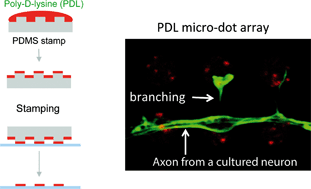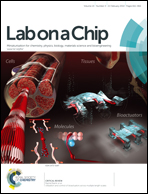Surface-printed microdot array chips for the quantification of axonal collateral branching of a single neuron in vitro†
Abstract
Precise and quantitative control of extracellular signalling cues using surface-engineered chips has facilitated various neurobiological assays in vitro. Although the formation of axon collateral branches is important for the establishment and refinement of the neuronal connections during the development and regeneration, surface designs for controlling branch phenotypes have been rarely proposed. In this work, we fabricated a surface-printed microdot array for controlling axon branch formation. Following the culture of hippocampal neurons on a 5 μm dot array patterned by micro-contact printing of poly-D-lysine, we found that most axon collateral branches were initiated from axonal regions on a microdot and terminated on neighboring dots. In addition, the length of branches increased as the spacing between dots increased. Surprisingly, other morphological features were not significantly different from the neurons cultured on a conventional unpatterned surface. Further investigation of this phenomenon indicated that the branch-forming machineries, such as actin patches, were focused on the dot. According to these investigations, we concluded that discontinuous adhesion spots given by dot arrays arranged the branching formation on the expectable location and direction. Therefore, microdot arrays will be applicable as the surface design parameter of bio-chip platforms to reduce branching complexity and quantize branching formation for the simple and easy assay in neurobiological studies.


 Please wait while we load your content...
Please wait while we load your content...